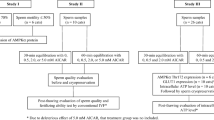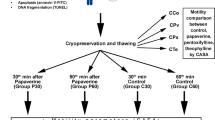Abstract
Extracellular adenosine 5 ′ -triphosphate (ATP) previously has been shown to increase the fertilization percentage in human in vitro fertilization (IVF) performed for male factor infertility. The objective of this study is to determine the e fects of extracellular adenosine 5 ′ -triphosphate (ATPe) on human sperm function by examining its e fects on end points of sperm capacitation. Sperm obtained from healthy volunteers with normal semen parameters, asthenozoospermic men, and cryopreserved samples were incubated in medium with or without 2.5 mM ATPe. The e fects of ATPe on acrosomal exocytosis, protein tyrosine phosphorylation, and sperm motility parameters were quantified. Although ATPe did not a fect acrosomal exocytosis or protein tyrosine phosphorylation in sperm from healthy donors, it significantly altered several motility parameters, with the largest e fects manifested in increased curvilinear velocity and percentage hyperactivation. ATPe similarly a fected sperm selected for poor motility and thawed cryopreserved sperm but to a lesser extent than its e fects on sperm with normal motility. ATPe increased straight-line velocity and linearity of sperm obtained from asthenozoospermic men. Human sperm motility characteristics are altered by ATPe; this finding may explain its previously reported beneficial e fect on human IVF. These results suggest that ATPe could constitute a new therapeutic modality in the treatment of male infertility.
Similar content being viewed by others
References
World Health Organization. WHO Laboratory Manual for the Examination of Human Semen and Sperm-Cervical Mucus Interaction. 4th ed. Cambridge, UK:Cambridge University Press; 1999.
Curi SM, Ariagno JI, Chenlo PH, et al. Asthenozoospermia: analysis of a large population. Arch Androl. 2003;49:343–349.
De Jonge C. Biological basis for human capacitation. Hum Reprod Update. 2005;11:205–214.
Buck J., Sinclair ML, Schapal L., Cann MJ, Levin LR Cytosolic adenylyl cyclase defines a unique signaling molecule in mammals. Proc Natl Acad Sci U S A. 1999;96:79–84.
Litvin TN, Kamenetsky M., Zarifyan A., Buck J., Levin LR Kinetic properties of “soluble” adenylyl cyclase: synergism between calcium and bicarbonate. J Biol Chem. 2003;278:15922–15926.
Jaiswal BS, Conti M. Calcium regulation of the soluble adenylyl cyclase expressed in mammalian spermatozoa. Proc Natl Acad Sci U S A. 2003;100:10676–10681.
Hess KC, Jones BH, Marquez B., et al. The “soluble” adenylyl cyclase in sperm mediates multiple signaling events required for fertilization. Dev Cell. 2005;9:249–259.
Henkel RR, Schill WB Sperm preparation for ART. Reprod Biol Endocrinol. 2003;1:108.
Yovich JL Pentoxifylline: actions and applications in assisted reproduction. Hum Reprod. 1993;8:1786–1791.
Tarlatzis BC, Kolibianakis EM, Bontis J., Tousiou M., Lagos S., Mantalenakis S. Effect of pentoxifylline on human sperm motility and fertilizing capacity. Arch Androl. 1995;34:33–42.
Dimitriadou F., Rizos D., Mantzavinos T., et al. The effect of pentoxifylline on sperm motility, oocyte fertilization, embryo quality, and pregnancy outcome in an in vitro fertilization program. Fertil Steril. 1995;63:880–886.
Scott L., Smith S. Human sperm motility-enhancing agents have detrimental effects on mouse oocytes and embryos. Fertil Steril. 1995;63:166–175.
Tournaye H., Van der Linden M., Van den Abbee E., Devroey P., Van Steirteghem A. Mouse in vitro fertilization using sperm treated with pentoxifylline and 2-deoxyadenosine. Fertil Steril. 1994;62:644–647.
Tournaye H., Devroey P., Camus M., Van der Linden M., Janssens R., Van Steirteghem A. Use of pentoxifylline in assisted reproductive technology. Hum Reprod. 1995;10(suppl 1):72–79.
Ricker DD, Minhas BS, Kumar R., Robertson JL, Dodson MG The effects of platelet-activating factor on the motility of human spermatozoa. Fertil Steril. 1989;52:655–658.
Roudebush WE, Toledo AA, Kort HI, Mitchell-Leef D., Elsner CW, Massey JB Platelet-activating factor significantly enhances intrauterine insemination pregnancy rates in non-male factor infertility. Fertil Steril. 2004;82:52–56.
Schwiebert EM ABC transporter-facilitated ATP conductive transport. Am J Physiol. 1999;276:C1–C8.
Burnstock G. Purinergic signalling. Br J Pharmacol. 2006; 147(suppl 1):S172–S181.
Karuhn RF, inventor. Method of predetermining time of ovulation in women and in animals to control conception. US patent 4036212. 1977.
Foresta C., Rossato M., Di Virgilio F. Extracellular ATP is a trigger for the acrosome reaction in human spermatozoa. J Biol Chem. 1992;267:19443–19447.
Rossato M., La Sala GB, Balasini M., et al. Sperm treatment with extracellular ATP increases fertilization rates in in-vitro fertilization for male factor infertility. Hum Reprod. 1999;14: 694–697.
Luria A., Rubinstein S., Lax Y., Breitbart H. Extracellular adenosine triphosphate stimulates acrosomal exocytosis in bovine spermatozoa via P2 purinoceptor. Biol Reprod. 2002; 66:429–437.
Skiba-Lahiani M., Auger J., Terribile J., et al. Stimulation of movement and acrosome reaction of human spermatozoa by PC12 liposomes encapsulating ATP. Int J Androl. 1995;18: 287–294.
Tomiyama T., Ohashi K., Tsutsui T., Saji F., Tanizawa O. Acrosome reaction induced in a limited population of human spermatozoa by progesterone (Ca(2+)-dependent) and ATP (Ca(2+)-independent). Hum Reprod. 1995;10:2052–2055.
Liu DY, Garrett C., Baker HW Acrosome-reacted human sperm in insemination medium do not bind to the zona pellucida of human oocytes. Int J Androl. 2006;29:475–481.
Cross NL, Morales P., Overstreet JW, Hanson FW Induction of acrosome reactions by the human zona pellucida. Biol Reprod. 1988;38:235–244.
Osheroff JE, Visconti PE, Valenzuela JP, Travis AJ, Alvarez J., Kopf GS Regulation of human sperm capacitation by a cholesterol efflux-stimulated signal transduction pathway leading to protein kinase A—mediated up-regulation of protein tyrosine phosphorylation. Mol Hum Reprod. 1999;5:1017–1026.
Visconti PE, Bailey JL, Moore GD, Pan D., Olds-Clarke P., Kopf GS Capacitation of mouse spermatozoa. I. Correlation between the capacitation state and protein tyrosine phosphorylation. Development. 1995;121:1129–1137.
Buffone MG, Doncel GF, Marin Briggiler CI, Vazquez-Levin MH, Calamera JC. Human sperm subpopulations: relationship between functional quality and protein tyrosine phosphorylation. Hum Reprod. 2004;19:139–146.
Mortimer ST Minimum sperm trajectory length for reliable determination of the fractal dimension. Reprod Fertil Dev. 1998;10:465–469.
Foresta C., Rossato M., Chiozzi P., Di Virgilio F. Mechanism of human sperm activation by extracellular ATP. Am J Physiol. 1996;270:C1709–C1714.
Liu DY, Baker HW Calcium ionophore-induced acrosome reaction correlates with fertilization rates in vitro in patients with teratozoospermic semen. Hum Reprod. 1998;13:905–910.
Carrera A., Moos J., Ning XP, et al. Regulation of protein tyrosine phosphorylation in human sperm by a calcium/calmodulindependent mechanism: identification of A kinase anchor proteins as major substrates for tyrosine phosphorylation. Dev Biol. 1996;180:284–296.
Visconti PE, Kopf GS Regulation of protein phosphorylation during sperm capacitation. Biol Reprod. 1998;59:1–6.
Urner F., Sakkas D. Protein phosphorylation in mammalian spermatozoa. Reproduction. 2003;125:17–26.
Maas DH, Storey BT, Mastroianni L. Jr. Hydrogen ion and carbon dioxide content of the oviductal fluid of the rhesus monkey (Macaca mulatta). Fertil Steril. 1977;28:981–985.
Vishwakarma P. The pH and bicarbonate-ion content of the oviduct and uterine fluids. Fertil Steril. 1962;13:481–485.
Donnelly ET, Lewis SE, McNally JA, Thompson W. In vitro fertilization and pregnancy rates: the influence of sperm motility and morphology on IVF outcome. Fertil Steril. 1998;70:305–314.
Talbot P., Chacon RS A triple-stain technique for evaluating normal acrosome reactions of human sperm. J Exp Zool. 1981;215:201–208.
Flesch FM, Gadella BM Dynamics of the mammalian sperm plasma membrane in the process of fertilization. Biochim Biophys Acta. 2000;1469:197–235.
Villalon M., Hinds TR, Verdugo P. Stimulus-response coupling in mammalian ciliated cells: demonstration of two mechanisms of control for cytosolic [Ca2+]. Biophys J. 1989;56:1255–1258.
Lieb T., Frei CW, Frohock JI, Bookman RJ, Salathe M. Prolonged increase in ciliary beat frequency after short-term purinergic stimulation in human airway epithelial cells. J Physiol. 2002;538:633–646.
Tatham PE, Cusack NJ, Gomperts BD Characterisation of the ATP4-receptor that mediates permeabilisation of rat mast cells. Eur J Pharmacol. 1988;147:13–21.
Darszon A., Nishigaki T., Wood C., Trevino CL, Felix R., Beltran C. Calcium channels and Ca2+ fluctuations in sperm physiology. Int Rev Cytol. 2005;243:79–172.
Felix R. Molecular physiology and pathology of Ca2+conducting channels in the plasma membrane of mammalian sperm. Reproduction. 2005;129:251–262.
Quill TA, Wang D., Garbers DL Insights into sperm cell motility signaling through sNHE and the CatSpers. Mol Cell Endocrinol. 2006;250:84–92.
Eppig JJ, Ward-Bailey PF, Coleman DL Hypoxanthine and adenosine in murine ovarian follicular fluid: concentrations and activity in maintaining oocyte meiotic arrest. Biol Reprod. 1985;33:1041–1049.
Fabiani R., Ronquist G. Abundance of guanine, guanosine, inosine and adenosine in human seminal plasma. Int J Clin Lab Res. 1995;25:47–51.
Aitken RJ, Mattei A., Irvine S. Paradoxical stimulation of human sperm motility by 2-deoxyadenosine. J Reprod Fertil. 1986;78:515–527.
Shen MR, Linden J., Chiang PH, Chen SS, Wu SN Adenosine stimulates human sperm motility via A2 receptors. J Pharm Pharmacol. 1993;45:650–653.
Vijayaraghavan S., Hoskins DD Regulation of bovine sperm motility and cyclic adenosine 3′,5′-monophosphate by adenosine and its analogues. Biol Reprod. 1986;34:468–477.
Schuh SM, Carlson AE, McKnight GS, Conti M., Hille B., Babcock DF Signaling pathways for modulation of mouse sperm motility by adenosine and catecholamine agonists. Biol Reprod. 2006;74:492–500.
Romac P., Zanic-Grubisic T., Culic O., Cvitkovic P., Flogel M. Sperm motility and kinetics of dynein ATPase in asthenoand normozoospermic samples after stimulation with adenosine and its analogues. Hum Reprod. 1994;9:1474–1478.
Konrad L., Schiemann P., Renneberg H., Wennemuth G., Fini C., Aumuller G. Expression and enzymic activity of ecto 5′nucleotidase in the human male genital tract. Biol Reprod. 1998;59:190–196.
Morales B., Barrera N., Uribe P., Mora C., Villalon M. Functional cross talk after activation of P2 and P1 receptors in oviductal ciliated cells. Am J Physiol Cell Physiol. 2000;279: C658–C669.
Guzick DS, Carson SA, Coutifaris C., et al. Efficacy of super-ovulation and intrauterine insemination in the treatment of infertility. National Cooperative Reproductive Medicine Network. N Engl J Med. 1999;340:177–183.
Author information
Authors and Affiliations
Corresponding author
Additional information
We thank Dr Francesco Di Virgilio for helpful discussions regarding experimental design and analysis and Dr Mary Sammel for assistance with statistical analysis.This work was supported by a grant from Duska Scientific Co to S.M. and C.J.W. G.L.G. was supported by the National Institutes of Health HD41552 and M.G.B. was supported by the International Training and Research Program in Population and Health (D43-TW00671).
Rights and permissions
About this article
Cite this article
Edwards, S.E., Buffone, M.G., Knee, G.R. et al. Effects of Extracellular Adenosine 5′-Triphosphate on Human Sperm Motility. Reprod. Sci. 14, 655–666 (2007). https://doi.org/10.1177/1933719107306227
Published:
Issue Date:
DOI: https://doi.org/10.1177/1933719107306227




